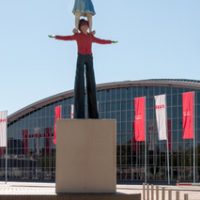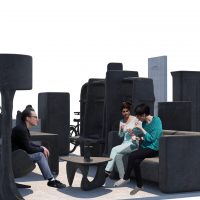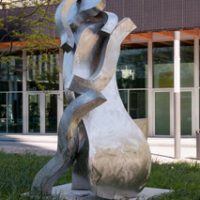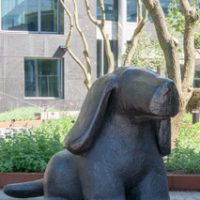Opgelichte stoeptegels, Rob Elderenbos, 1984
Van der Boechorstraat/De Boelelaan
Public space is contested. Sometimes art has to make way for daily life. For a long time, this work by Rob Elderenbos stood alongside the Transitorium, but it has been removed.
Urban space can be understood in two ways: on the one hand there are the urban planners, architects, contractors and the city council who are in charge of the buildings, roads, green spaces, etc. On the other hand there are people who use the space, who fill the city with social activity. That activity is influenced by the space in which it takes place, but at the same time a city is shaped by its users. This last aspect is reflected in what could be called ‘the significance of an open space’.
Opgelichte Stoeptegels(uplifted paving stones) by Rob Elderenbos was originally situated at the intersection of Van Der Boechorstraat and De Boelenlaan, on a narrow sidewalk along a busy street. Large steel plates break through the pavement. They resemble the kind of steel plates often used on construction sites as temporary walkways. As such, the work can be seen as a charming interruption of daily life: a seemingly banal sidewalk is turned into an aesthetic object to be observed. However, the work was not meant to evoke contemplation. It was part of a movement in the 1970’s called ‘omgevingsvormgeving’ (which means as much environmental design). Affiliated artists thought art was not meant to decorate public space or fill it with extra layers of meaning. Instead they thought art should stimulate the insipid setting of modern urban development. Opgelichte Stoeptegels is a great example of the kind of work that makes people aware of the space they move around in, but it does so in a disrupting way. Because, well, it is ín the way: you can barely go around it. Obviously, this may irritate pedestrians. The work was part of public space until 2013, but was then removed. The removal proves the power of the user: urban planners really need to take into account the people in the city and their demands for the public domain. The contemporary citizen is quite irritable.
At Kleinpolderplein in Rotterdam is the Museum voor Verweesde Beelden (museum for orphaned sculptures) which accommodates artworks that no longer function in their original location. Perhaps they have room for Opgelichte Stoeptegels too.
More information
–









